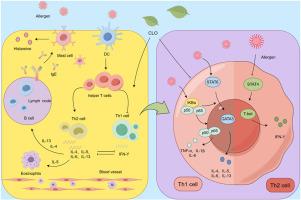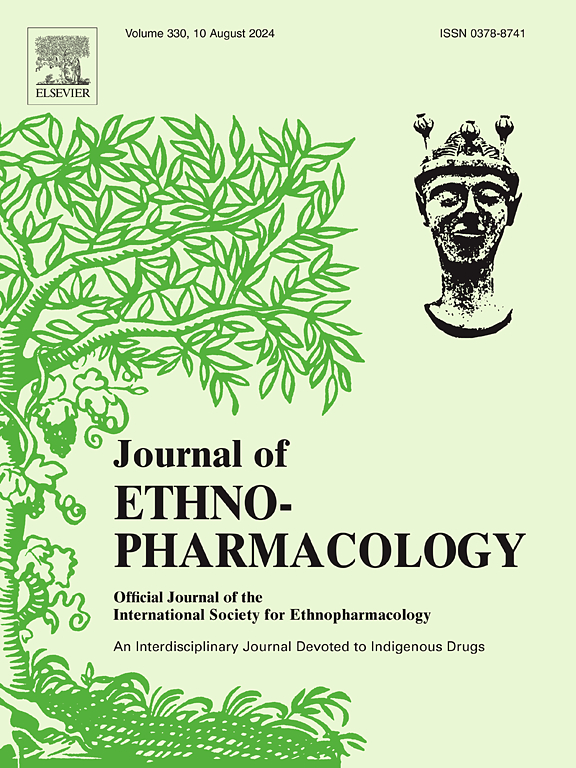The protective effects and mechanisms of essential oil from Chimonanthus nitens Oliv. leaves in allergic rhinitis based on the NF-κB and T-bet/GATA-3 signaling pathways
IF 4.8
2区 医学
Q1 CHEMISTRY, MEDICINAL
引用次数: 0
Abstract
Ethnopharmacological relevance
Preliminary studies showed that Shanlameiye granules are derived from Chimonanthus nitens Oliv. Leaves ameliorate inflammatory responses in mice with Allergic Rhinitis (AR). The essential oil from Chimonanthus nitens Oliv. Leaves (CLO) have been identified as the key active substances in these granules. However, whether CLO constitutes the primary mechanism for the mitigation of AR-related inflammation by these granules has not yet been investigated.
Aim of the study
This experiment was to validate the effects and mechanism of CLO on inflammatory responses in RAW264.7 cells and AR rat model.
Materials and methods
An inflammatory model was induced in RAW264.7 cells by Lipopolysaccharide (LPS) & Interferon-gamma (IFN-γ) stimulation. AR rat model was established using both systemic and local challenges with Ovalbumin (OVA).
Results
In cell experiments, CLO obviously decreased the secretion of cytokines and inhibited the NF-κB signaling pathway activation. In animal experiments, CLO decreased the number of eosinophils in the blood and lowered the levels of cytokines in nasal lavage fluid (NALF). Additionally, CLO inhibited the expression of STAT6, GATA-3, and p-p65, while increasing the expression of STAT4 and T-bet in the nasal mucosa.
Conclusion
In AR rat model, CLO may play an anti-inflammatory role in AR rat model by regulating NF-κB and T-bet/GATA-3 signaling pathways.

基于 NF-κB 和 T-bet/GATA-3 信号通路的 Chimonanthus nitens Oliv.
民族药理学相关性初步研究表明,Shanlameiye 颗粒提取自 Chimonanthus nitens Oliv.叶可改善过敏性鼻炎(AR)小鼠的炎症反应。Chimonanthus nitens Oliv.叶中的精油(CLO)已被确定为这些颗粒中的主要活性物质。本实验旨在验证 CLO 对 RAW264.7 细胞和 AR 大鼠模型中炎症反应的影响和机制。结果在细胞实验中,CLO 能明显减少细胞因子的分泌,抑制 NF-κB 信号通路的激活。在动物实验中,CLO 降低了血液中嗜酸性粒细胞的数量,并降低了鼻腔灌洗液(NALF)中细胞因子的水平。结论在 AR 大鼠模型中,CLO 可通过调节 NF-κB 和 T-bet/GATA-3 信号通路发挥抗炎作用。
本文章由计算机程序翻译,如有差异,请以英文原文为准。
求助全文
约1分钟内获得全文
求助全文
来源期刊

Journal of ethnopharmacology
医学-全科医学与补充医学
CiteScore
10.30
自引率
5.60%
发文量
967
审稿时长
77 days
期刊介绍:
The Journal of Ethnopharmacology is dedicated to the exchange of information and understandings about people''s use of plants, fungi, animals, microorganisms and minerals and their biological and pharmacological effects based on the principles established through international conventions. Early people confronted with illness and disease, discovered a wealth of useful therapeutic agents in the plant and animal kingdoms. The empirical knowledge of these medicinal substances and their toxic potential was passed on by oral tradition and sometimes recorded in herbals and other texts on materia medica. Many valuable drugs of today (e.g., atropine, ephedrine, tubocurarine, digoxin, reserpine) came into use through the study of indigenous remedies. Chemists continue to use plant-derived drugs (e.g., morphine, taxol, physostigmine, quinidine, emetine) as prototypes in their attempts to develop more effective and less toxic medicinals.
 求助内容:
求助内容: 应助结果提醒方式:
应助结果提醒方式:


